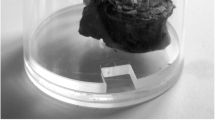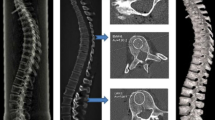Summary
We compared indices of three-dimensional microstructure of iliac trabecular bone between 26 patients with vertebral compression fractures due to postmenopausal osteoporosis and 24 control subjects without vertebral fracture, who were matched for age, sex, race, menopausal status, and several densitometric and histologic indices of both cortical and trabecular bone mass. The patients with fracture had a significantly lower mean value (1.03±0.15 vs. 1.26±0.26;P<0.005) for indirectly calculated mean trabecular plate density, an index of the number and connectivity of structural elements, and as a necessary corollary, a significantly higher mean value for the mean thickness of structural elements. Plate density was more than one standard deviation below the age-adjusted mean value for normal postmenopausal white females in 19 (73%) of the fracture caes and in only 5 (21%) of the nonfracture cases (P<0.001). We conclude that the biomechanical competence of trabecular bone is dependent not only on the absolute amount of bone present but also on the trabecular microstructure.
Similar content being viewed by others
References
Weaver JK, Chalmers J (1966) Cancellous bone: its strength and changes with aging and an evaluation of some methods for measuring its mineral content. J Bone Joint Surg 48A:289–298
Hansson T, Roos B, Nachemson A (1980) The bone mineral content and ultimate compressive strength of lumbar vertebrae. Spine 5:46–55
Garn SM (1981) The phenomenon of bone formation and bone loss. In: DeLuca HF, Frost HM, Jee WSS, Johnston CC Jr, Parfitt AM (eds) Osteoporosis: recent advances in pathogenesis and treatment. University Park Press Baltimore, p 3
Melton LJ III, Riggs BL (1983) Epidemiology of age-related fractures. In: Avioli LV, (ed) The osteoporotic syndrome. Detection, prevention, and treatment. Grune & Stratton, New York p 45
Smith DM, Khairi MRA, Johnston CC (1975) The loss of bone mineral with aging and its relationship to risk of fracture. J Clin Invest 56:311–318
Meunier PJ, Sellami S, Briancon D, Edouard C (1981) Histological heterogeneity of apparently idiopathic osteoporosis. In: DeLuca HF, Frost HM, Jee WSS, Johnston CC Jr, Parfitt AM (eds) Osteoporosis: recent advances in patho-genesis and treatment. University Park Press, Baltimore, p 293
Riggs BL, Wahner HW, Seeman E et al (1982) Changes in bone mineral density of the proximal femur and spine with aging. Differences between the postmenopausal and senile osteoporosis syndromes. J Clin Invest 70:716–723
Cann CE, Genant HK, Kolb FO, Ettinger B (1985) Quantitative computed tomography for prediction of vertebral fracture risk. Bone 6:1–8
Parfitt AM, Mathews CHE, Villanueva AR, Kleerekoper M, Frame B, Rao DS (1983) Relationship between surface, volume and thickness of iliac trabecular bone in aging and in osteoporosis: implications for the microanatomic and cellular mechanism of bone loss. J Clin Invest 72:1396–1409
Parfit AM, Villanueva AR, Stanciu J, Kleerekoper M (1984) The role of three-dimensional trabecular microstructure in the pathogenesis of vertebral compression fractures Clin Res 32:764A
Schwartz MP, Recker RR (1981) Comparison of surface density and volume of human iliac trabecular bone measured directly and by applied stereology. Calcif Tissue Int 33:561–565
Parfitt AM, Pødenphant J, Villanueva AR, Frame B (1985) Metabolic bone disease with and without osteomalacia after intestinal bypass surgery: a bone histomorphometric study. Bone 6:193–201
Kleerekoper M, Villanueva AR, Mathews CHE, Rao DS, Pumo B, Parfitt AM (1983) PTH-mediated bone loss in primary and secondary hyperparathyroidism. In: Frame B, Potts JT Jr (eds) Clinical disorders of bone and mineral metabolism. Excerpta Medica, Amsterdam, p 200
Colton T (1974) Statistics in medicine. Little Brown & Co. Boston
Sokal RR, Rohlf FJ (1981) Biometry 2nd ed. W. H. Freeman, San Francisco
Pugh JW, Radin EL, Rose RM (1974) Quantitative studies of human subchondral cancellous bone. Its relationship to the state of its overlying cartilage. J Bone Joint Surg 56A:313–321
Manicourt DH, Orloff S, Brauman J, Schoutens A (1981) Bone mineral content of the radius: good correlations with physicochemical determinations in iliac crest trabecular bone of normal and osteoporotic subjects. Metabolism 30:57–62
Burnell JM, Baylink DJ, Chestnut Ch III, Mathews, MW, Teubner EJ (1982) Bone matrix and mineral abnormalities in postmenopausal osteoporosis. Metabolism 31:1113–1120
Whitehouse WJ (1977) Cancellous bone in the anterior part of the iliac crest. Calcif Tissue Res 23:67–76
DeHoff RT (1983) Quantitative serial sectioning analysis: preview. J Microsc 131:259–263
Pesch H-J, Scharf H-P, Lauer G, Seibold H (1980) Der altersabhängige Verbundbau der Lendenwirbelkörper. Eine Struktur- und Formanalyse. Virchows Arch A Pathol Anat Histol 386:21–41
Meunier P, Courpron P (1976) Iliac trabecular bone volume in 236 controls—representativeness of iliac samples. In: Jaworski ZFG (ed) Bone morphometry. University of Ottawa Press, Ottawa, p 100
Johnston CC Jr, Hui SL, Wiske P, Norton JA Jr, Epstein S (1981) Bone mass at maturity and subsequent rates of loss as determinants of osteoporosis. In: DeLuca HF, Frost HM, Lee WSS, Johnston CC Jr, Parfitt AM (eds) Osteoporosis: recent advances in pathogenesis and treatment. University Park Press, Baltimore, p 285
Parfitt Am (1984) Age-related structural changes in trabecular and cortical bone: cellular mechanism and biomechanical consequences. (a) Differences between rapid and slow bone loss. (b) Localized bone gain. Calcif Tissue Int 36:S123–128
Reeve J (in press) A stochastic analysis of iliac trabecular bone dynamics. Clin Ortho Rel Res
Rasmussen H, Bordier PJ (1974) The physiological and cellular basis of metabolic bone disease. Williams and Wilkins, Baltimore
Feldkamp LA, Kleerekope M, Kress JW, Freeling R, Mathews CHE, Parfitt AM (1983) Investigation of three-dimensional structure of trabecular bone by computed tomography of iliac biopsy samples. Calcif Tissue Int 35:669
Author information
Authors and Affiliations
Rights and permissions
About this article
Cite this article
Kleerekoper, M., Villanueva, A.R., Stanciu, J. et al. The role of three-dimensional trabecular microstructure in the pathogenesis of vertebral compression fractures. Calcif Tissue Int 37, 594–597 (1985). https://doi.org/10.1007/BF02554913
Issue Date:
DOI: https://doi.org/10.1007/BF02554913




